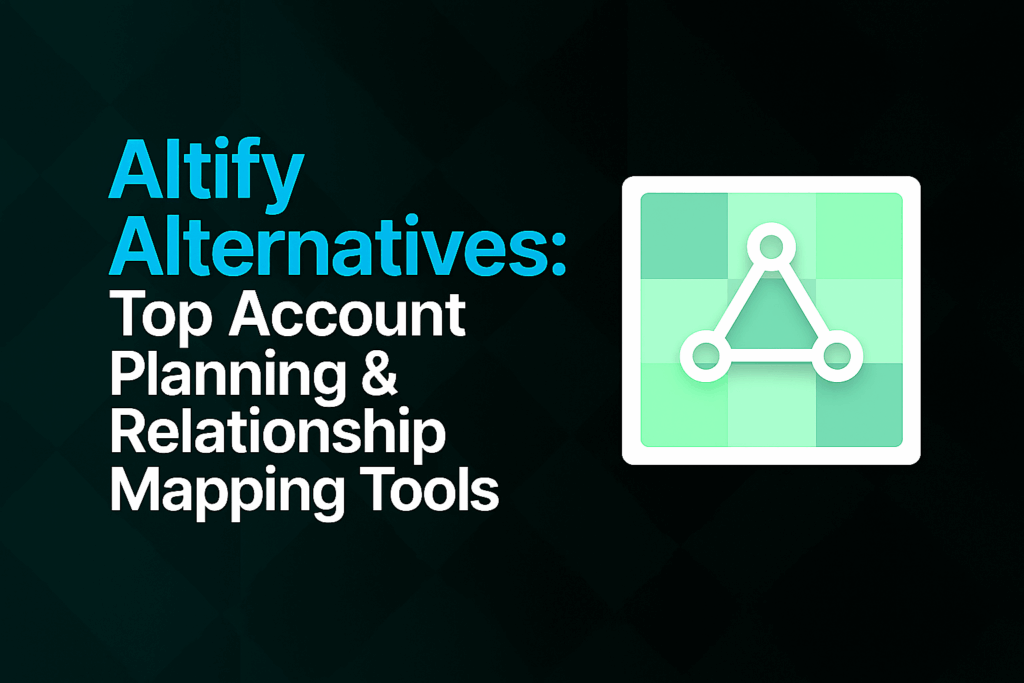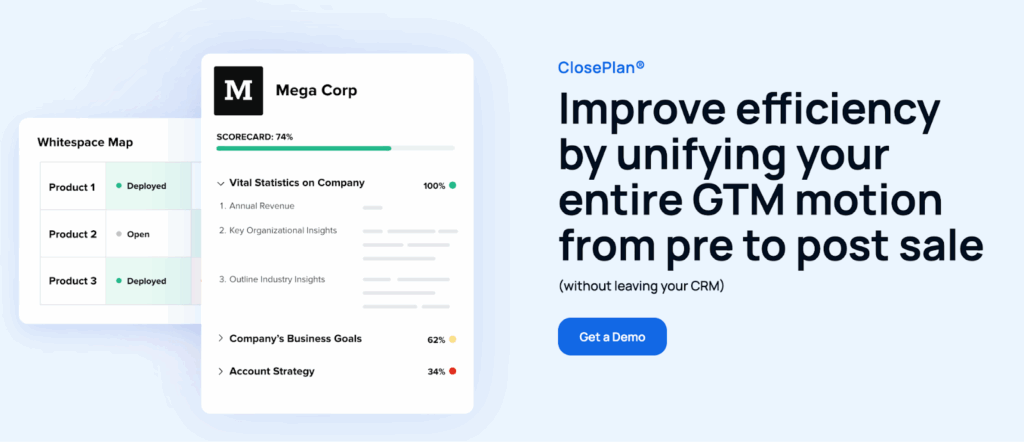Ever watched a perfectly orchestrated sales deal fall apart because someone missed a crucial stakeholder? You’re not alone.
The truth is buying committees today involve 12-14 people, not the traditional six we’ve been planning for. Meanwhile, 75% of B2B buyers take longer to make decisions now than in 2023, creating longer sales cycles and more complex stakeholder webs than ever before.
The old playbook of tracking contacts in spreadsheets and hoping for the best? That’s organizational suicide in today’s hyper-competitive landscape.
Strategic account planning has evolved from a “nice-to-have” to mission-critical infrastructure. 47% of B2B marketers use account-based approaches to improve efficiency and boost ROI, and the results speak volumes.
But here’s where it gets interesting: while Altify (now part of Salesforce Revenue Cloud) pioneered structured account planning, the market has exploded with innovative alternatives that are rewriting the rules of strategic account management.
The Altify Era: What It Got Right (And Where It’s Showing Age)
Credit where credit’s due. Altify didn’t just create account planning software. It sort of invented the category. Built on battle-tested frameworks like Target Account Selling (TAS), it brought military-grade precision to the chaos of enterprise sales. For years, it was the gold standard for organizations serious about strategic account growth.
The platform’s DNA runs deep in methodology. Structured opportunity management, systematic stakeholder analysis, and disciplined account planning processes—these weren’t just features, they were competitive advantages that separated professional account managers from order-takers.
But here’s the thing about pioneering solutions: they often become victims of their own success. What once felt revolutionary can start feeling… well, like wearing a three-piece suit to a startup pitch.
Functional? Absolutely. Inspiring daily adoption across your entire sales organization? That’s where the conversation gets interesting.
The Great Migration: Why Account Teams Are Seeking New Horizons
The Cost-Value Equation Gets Complicated
- Let’s talk numbers. Enterprise software budgets are under unprecedented scrutiny, and 83% of marketing leaders now consider demonstrating ROI as their top priority. When you’re paying premium prices for comprehensive functionality but only utilizing a fraction of features, the math gets uncomfortable fast.
- License costs per user that create artificial barriers to organization-wide adoption. Strategic account planning works best when it’s democratized across your entire account team—not locked away in a ivory tower accessible only to senior account managers.
The Adoption Paradox
- Investing in sophisticated tools that collect digital dust because the user experience feels like archaeological work. Complex navigation, steep learning curves, and workflow friction create a vicious cycle where only power users embrace the platform while the broader team reverts to spreadsheets and tribal knowledge.
- The most elegant account planning strategy becomes worthless if your account managers spend more time fighting the interface than understanding their stakeholders.
Visual Intelligence: The New Battleground
- The average buying group consists of 4-10 members, with operational leaders and managers accounting for the majority of decision makers. Now imagine trying to navigate these complex influence networks through static org charts and text-heavy interfaces.
- Today’s account managers think visually. They need to see stakeholder relationships, influence patterns, and expansion opportunities at a glance—not buried in reports that require archaeology degrees to interpret.
Integration Nightmares in the Modern Sales Stack
- Even Salesforce-native solutions can become integration headaches when they don’t play nicely with the 10+ other tools in your sales technology stack. Account managers shouldn’t need to toggle between platforms to gather complete stakeholder intelligence or manually sync data across systems.
- The goal isn’t adding another tool to your stack—it’s creating seamless workflow enhancement that makes complex account planning feel effortless.
The New Evaluation Playbook: What Actually Matters
When evaluating next-generation account planning platforms, ignore the feature checklists and focus on these game-changing capabilities:
- Visual Storytelling: Can your account managers understand complex stakeholder dynamics in seconds, not minutes? The best platforms transform data into visual narratives that immediately communicate opportunities and risks.
- Intelligence Depth: Beyond basic contact management, does it capture the subtle influence patterns, sentiment shifts, and relationship dynamics that determine deal outcomes?
- Expansion Radar: How does it identify whitespace opportunities? The best platforms don’t just show gaps—they predict where expansion conversations will succeed based on stakeholder influence and organizational dynamics.
- Workflow Integration: Does it enhance your existing sales process or create parallel workflows that compete for attention?
- Adoption Velocity: How quickly can new team members become productive? The most sophisticated platform fails if adoption feels like learning a new language.
Top 5 Altify Alternatives for 2025
1. DemandFarm – The Ultimate Visual Account Intelligence Platform
DemandFarm represents next-generation account planning, designed for organizations that need sophisticated account intelligence without complex implementation. The platform transforms traditional account planning into visually intuitive experiences that drive consistent adoption.
Key Differentiators:
a. Dynamic Relationship Mapping:
Auto-generates stakeholder maps from CRM data, providing real-time visualization of influence networks and engagement patterns. AI-powered mapping identifies hidden connections and suggests missing stakeholders based on typical buying committee structures.
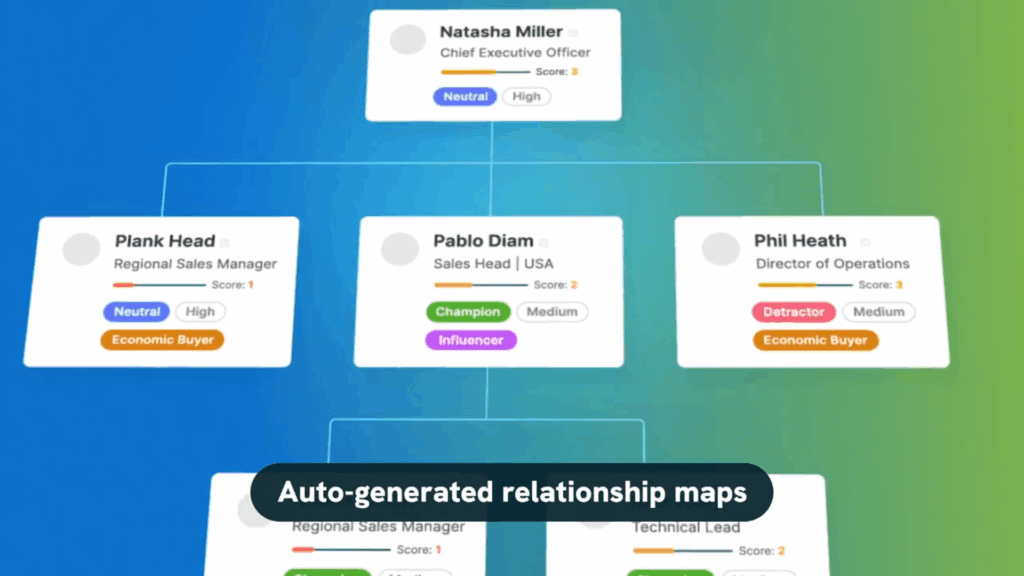
b. Comprehensive Whitespace Analysis: Goes beyond basic product gap analysis to identify expansion opportunities based on stakeholder influence, budget timing, and strategic initiatives. Predictive algorithms prioritize opportunities using multiple success factors.
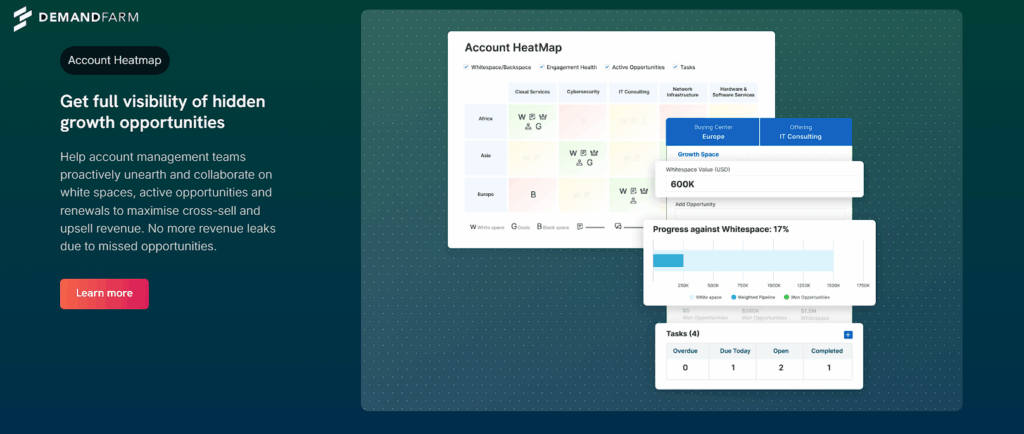
c. Centralized Account Intelligence: Creates a single source of truth for all account knowledge, ensuring critical insights survive team changes and supporting seamless collaboration across sales, customer success, and marketing teams.
d. Visual Deal Planning: Transforms complex opportunity management into clear visual workflows that track stakeholder sentiment, identify potential roadblocks, and guide strategic positioning throughout the sales cycle.
e. Native Salesforce Integration: Provides deep, real-time integration that enhances existing CRM investment while maintaining familiar workflows.
f. Value Proposition: DemandFarm simplifies complex account planning into actionable visual intelligence, empowering account managers to consistently drive growth while ensuring tribal knowledge never walks out the door.
Best For: Mid-market to enterprise B2B organizations with complex stakeholder environments, extended sales cycles, and significant account expansion opportunities.

2. Revegy – Methodology-Driven Account Planning
Revegy focuses on structured sales methodology for strategic account planning, with particular strength in opportunity coaching and deal strategy development.
Key Features:
- Built-in frameworks for opportunity qualification and competitive positioning
- Guided workflows for deal strategy development and stakeholder analysis
- Pre-built templates for different account types and sales scenarios
- Strong coaching tools for developing account management capabilities
Best For: Organizations with established sales methodologies seeking to systematize account planning processes and improve deal strategy consistency.
Limitations: May feel rigid for organizations preferring flexible, visual approaches. The methodology focus can create adoption challenges for teams comfortable with less structured approaches.
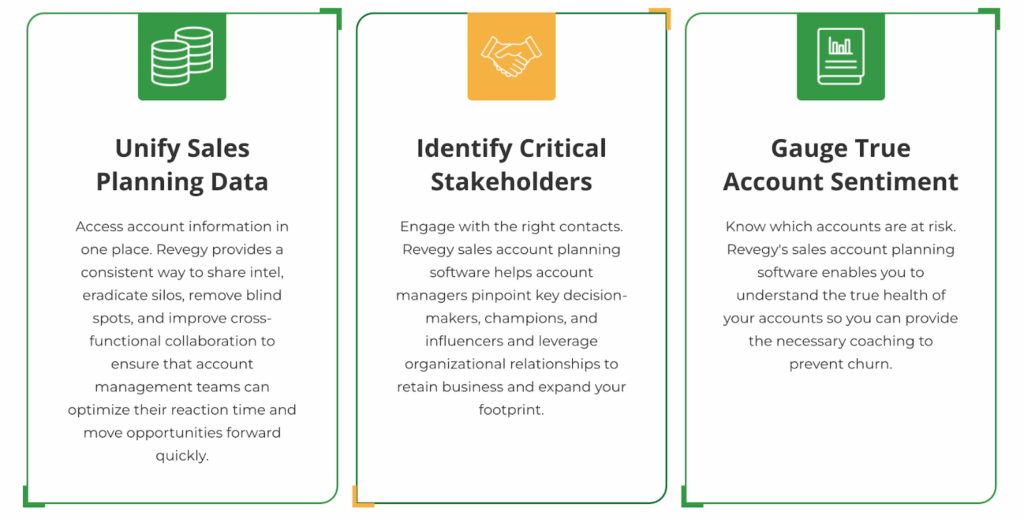
3. Kapta – Customer Success-Focused Account Management
Kapta approaches account planning from a customer success perspective, emphasizing retention, expansion, and long-term relationship management.
Key Features:
- Automated customer health scoring based on engagement patterns
- Structured quarterly business reviews and success planning
- Strong cross-functional collaboration capabilities
- Predictive insights for churn risk and expansion timing
Best For: Customer success organizations, subscription businesses, and companies with long-term strategic partnerships requiring ongoing relationship management.
Limitations: Less suitable for organizations focused on new business development or complex sales cycle management.
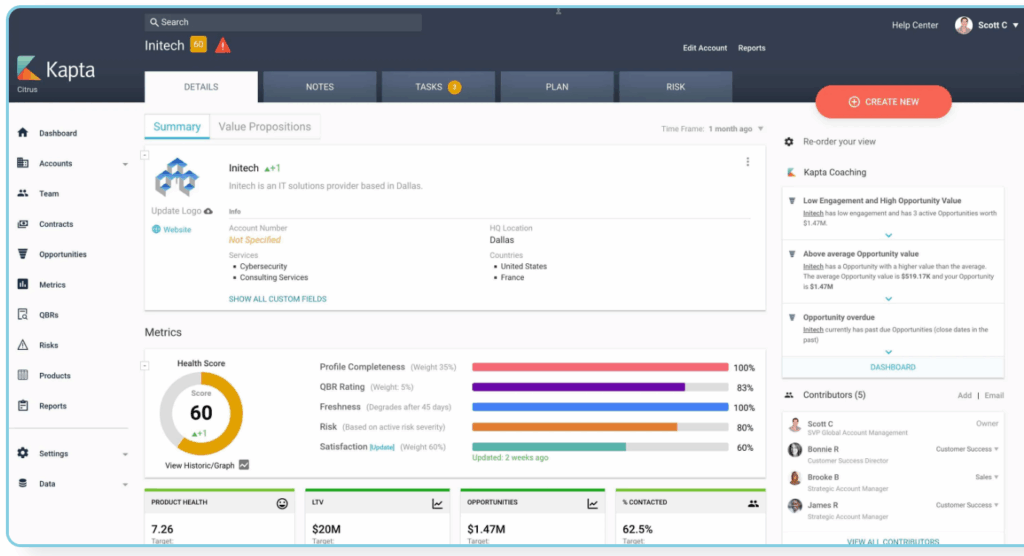
4. Closeplan – Deal-Focused Opportunity Management
Closeplan emphasizes opportunity-level planning with integrated stakeholder mapping and competitive analysis.
Key Features:
- Collaborative deal rooms for opportunity planning and execution
- Visual stakeholder mapping within deal contexts
- Competitive intelligence and win/loss analysis tools
- Forecasting integration with pipeline prediction models
Best For: Sales teams with complex deal cycles, multiple stakeholders per opportunity, and significant competitive dynamics requiring detailed deal strategy.
Limitations: May not provide comprehensive account-level intelligence needed for true strategic account planning.
5. Native CRM Solutions – Salesforce Sales Cloud and HubSpot
Both platforms offer account planning capabilities through core CRM functionality, often supplemented by marketplace applications.
Salesforce Sales Cloud: Provides basic account planning through account hierarchy management and extensive third-party integrations. Strength lies in customization capabilities.
HubSpot: Offers account-based marketing integration and deal pipeline management. Emphasizes ease of use and integrated marketing automation.
Best For: Organizations preferring to build account planning capabilities within existing CRM investment or those with simple requirements.
Limitations: Typically require significant customization or third-party integrations to match specialized functionality of dedicated account planning tools.
Making the Right Choice
Audit Your Current Pain Points
Document specific areas where your existing platform falls short—whether related to user adoption, visual clarity, integration complexity, or feature gaps. Survey your account management team to understand daily workflow challenges.
Prioritize Essential Requirements
Create a prioritized list based on your pain point analysis. Consider visual intelligence needs, integration complexity, user adoption requirements, and budget constraints. The most feature-rich platform may not be the best fit if adoption barriers outweigh functionality benefits.
Evaluate Team Readiness
Assess your team’s readiness for platform transition, including comfort with new technology and capacity for training. Consider pilot programs with shortlisted platforms to evaluate real-world usage patterns before making final decisions.
Request Hands-On Demonstrations
Move beyond vendor presentations to hands-on evaluation using your actual account data. Focus on how each platform handles your specific use cases rather than generic feature comparisons.
Conclusion: Beyond Legacy to Next-Generation Intelligence
The strategic account planning landscape has evolved beyond traditional CRM extensions to sophisticated intelligence platforms that transform how organizations understand and grow their most valuable relationships. While Altify established important foundations, today’s sales leaders need solutions that provide immediate visual insights, drive consistent user adoption, and ensure critical account knowledge scales with their organization.
The most successful implementations combine sophisticated functionality with intuitive user experiences, creating platforms that enhance rather than complicate daily account management activities. Whether you choose DemandFarm’s visual intelligence approach, Revegy’s methodology-driven framework, or another specialized solution, the key is selecting a platform that aligns with your organization’s specific needs and strategic objectives.
As buying committees become more complex and stakeholder networks continue expanding, organizations that invest in next-generation account planning platforms will gain sustainable competitive advantages in relationship intelligence and strategic account growth.
Ready to transform your strategic account planning approach? The future of account intelligence is visual, intuitive, and designed for the complexity of modern B2B relationships.
